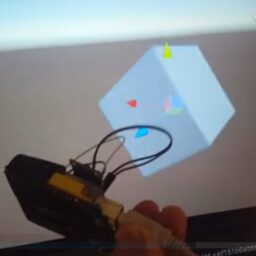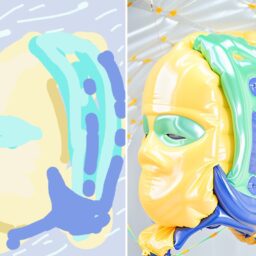// esp32 with analog joystick in >>> variables from 0-4095 Ähnliche Beiträge: gyroscope data to unity via Arduino serial experimental …
// esp32 with analog joystick in >>> variables from 0-4095
#include <Arduino.h>
// analog joysticks need to be connected with 3.3V!
#define J1XPIN 34
#define J1YPIN 35
#define J2XPIN 32
#define J2YPIN 33
int j1_x_raw;
int j1_y_raw;
int j2_x_raw;
int j2_y_raw;
void setup()
{
Serial.begin(9600);
}
void loop()
{
j1_x_raw = analogRead(J1XPIN);
j1_y_raw = analogRead(J1YPIN);
j2_x_raw = analogRead(J2XPIN);
j2_y_raw = analogRead(J2YPIN);
float j1x = float(j1_x_raw) * 0.00024420024;
float j1y = float(j1_y_raw)* 0.00024420024;
float j2x = float(j2_x_raw)* 0.00024420024;
float j2y = float(j2_y_raw)* 0.00024420024;
Serial.print (int(j1x*100));
Serial.print(" = ");
Serial.print(int(j1y*100));
Serial.print(" // ");
Serial.print (int(j2x*100));
Serial.print(" = ");
Serial.println(int(j2y*100));
delay(100);
}
#include <Arduino.h>
#include "LedControl.h"
int joy1X = 0;
int joy1Y = 1;
bool joy1BTN = false;
int p1BTN_PIN = 14;
int joy2X = 2;
int joy2Y = 3;
bool joy2BTN = false;
int p2BTN_PIN = 10;
/*
Now we need a LedControl to work with.
***** These pin numbers will probably not work with your hardware *****
pin 12 is connected to the DataIn
pin 11 is connected to the CLK
pin 10 is connected to LOAD
We have only a single MAX72XX.
*/
LedControl lc=LedControl(16,9,8,1);
void drawGATE(int _x, int _y){
lc.setLed(0,_x-1,_y,true);
lc.setLed(0,_x+1,_y,true);
lc.setLed(0,_x,_y-1,true);
lc.setLed(0,_x,_y+1,true);
}
int getArrayIndex(int x, int y) {
if (x < 0 || x >= 7 || y < 0 || y >= 7) {
// Invalid position
// You may choose to handle the error in a specific way, like printing an error message or taking appropriate action
// For simplicity, let's just return -1 to indicate an error
return -1;
}
int index = y * 7 + x;
return index;
}
bool buffer[64];
//-------------
void setup() {
/*
The MAX72XX is in power-saving mode on startup,
we have to do a wakeup call
*/
lc.shutdown(0,false);
/* Set the brightness to a medium values */
lc.setIntensity(0,2);
/* and clear the display */
lc.clearDisplay(0);
pinMode(p1BTN_PIN,INPUT_PULLUP);
pinMode(p2BTN_PIN,INPUT_PULLUP);
lc.setLed(0,3,3,1);
for(int i=0;i<64;i++){
buffer[i]=false;
if(random(100)>80){
buffer[i]=true;
}
}
}
float px2 = 2;
float py2 = 2;
float ax2 = -.02;
float ay2 = .03;
float px = 2;
float py = 2;
float ax = .2;
float ay = .4;
int p1_direct_x = 0;
int p1_direct_y = 0;
int p1_in_x = 0;
int p1_in_y = 0;
int p2_in_x = 0;
int p2_in_y = 0;
int p2_mapped_x = 0;
int p2_mapped_y = 0;
int p1_mapped_x = 0;
int p1_mapped_y = 0;
int animtick = 0;
bool a_phase = false;
void drawBuffer(){
int tick=0;
for(int x=0;x<8;x++){
for(int y=0;y<8;y++){
if( buffer[tick] == true){
lc.setLed(0,x,y,true);
}else{
lc.setLed(0,x,y,false);
}
tick++;
}
}
}
void loop() {
p1_in_x = analogRead(joy1X);
p1_in_y = analogRead(joy1Y);
p2_in_x = analogRead(joy2X);
p2_in_y = analogRead(joy2Y);
joy1BTN = digitalRead(p1BTN_PIN);
joy2BTN = digitalRead(p2BTN_PIN);
p1_mapped_x = int(map(p1_in_x, 0,1023, -100, 100));
p1_mapped_y = int(map(p1_in_y, 0,1023, -100, 100));
p1_direct_x = int(map(p1_in_x, 0,1023, 0, 7));
p1_direct_y = int(map(p1_in_y,0,1023,0,7) );
p2_mapped_x = int(map(p2_in_x, 0,1023, -100, 100));
p2_mapped_y = int(map(p2_in_y, 0,1023, -100, 100));
//lc.clearDisplay(0);
drawBuffer();
px += ax;
py += ay;
px2 += p2_mapped_x*.002;
py2 += p2_mapped_y*.002;
if(px>7 || px <=0){ ax*=-1;}
if(py>7 || py<=0){ ay*=-1;}
if(px2>7 ){ px2=7;}
if(py2>7 ){ py2=7;}
if(px2<0 ){ px2=0;}
if(py2<0 ){ py2=0;}
if(joy1BTN != 0){
// lc.setLed(0,p1_direct_x,p1_direct_y,true);
}else{
// drawGATE(p1_direct_x,p1_direct_y);
}
if(joy2BTN != 0){
int bid = getArrayIndex(int(px2),int(py2));
buffer[bid] = !buffer[bid];
}
lc.setLed(0,px2,py2,a_phase);
if(animtick>10){
animtick=0;
a_phase=true;
}else{
animtick++;
if(animtick>8){
a_phase=false;
}
}
delay(10);
// put your main code here, to run repeatedly:
}


